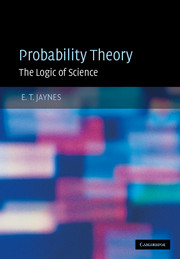Book contents
- Frontmatter
- Contents
- Editor's foreword
- Preface
- Part I Principles and elementary applications
- 1 Plausible reasoning
- 2 The quantitative rules
- 3 Elementary sampling theory
- 4 Elementary hypothesis testing
- 5 Queer uses for probability theory
- 6 Elementary parameter estimation
- 7 The central, Gaussian or normal distribution
- 8 Sufficiency, ancillarity, and all that
- 9 Repetitive experiments: probability and frequency
- 10 Physics of ‘random experiments’
- Part II Advanced applications
- Appendix A Other approaches to probability theory
- Appendix B Mathematical formalities and style
- Appendix C Convolutions and cumulants
- References
- Bibliography
- Author index
- Subject index
8 - Sufficiency, ancillarity, and all that
from Part I - Principles and elementary applications
Published online by Cambridge University Press: 05 September 2012
- Frontmatter
- Contents
- Editor's foreword
- Preface
- Part I Principles and elementary applications
- 1 Plausible reasoning
- 2 The quantitative rules
- 3 Elementary sampling theory
- 4 Elementary hypothesis testing
- 5 Queer uses for probability theory
- 6 Elementary parameter estimation
- 7 The central, Gaussian or normal distribution
- 8 Sufficiency, ancillarity, and all that
- 9 Repetitive experiments: probability and frequency
- 10 Physics of ‘random experiments’
- Part II Advanced applications
- Appendix A Other approaches to probability theory
- Appendix B Mathematical formalities and style
- Appendix C Convolutions and cumulants
- References
- Bibliography
- Author index
- Subject index
Summary
In the preceding five chapters we have examined the use of probability theory in problems that, although technically elementary, illustrated a fairly good sample of typical current applications. Now we are in a position to look back over these examples and note some interesting features that they have brought to light. It is useful to understand these features, for tactical reasons. Many times in the past when one tried to conduct inference by applying intuitive ad hoc devices instead of probability theory, they would not work acceptably unless some special circumstances were present, and others absent. Thus they were of major theoretical importance in orthodox statistics.
None of the material of the present chapter, however, is really needed in our applications; for us, these are incidental details that take care of themselves as long as we obey the rules. That is, if we merely apply the rules derived in Chapter 2, strictly and consistently in every problem, they lead us to do the right thing and arrive at the optimal inferences for that problem automatically, without our having to take any special note of these things. For us, they have rather a ‘general cultural value’ in helping us to understand better the inner workings of probability theory. One can see much more clearly why it is necessary to obey the Chapter 2 rules, and the predictable consequences of failure to do so.
Information
- Type
- Chapter
- Information
- Probability TheoryThe Logic of Science, pp. 243 - 269Publisher: Cambridge University PressPrint publication year: 2003
